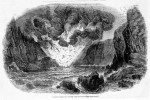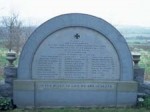 Most families probably have a sprinkling of legends, anecdotes and stories that most of us probably take with a pinch of salt. Professional genealogists are very wary of family tree legends, as they are often based on shaky evidence, have been passed down and exaggerated through generations, and are not usually provable. However, investigating these stories and legends can be a fascinating way to discover your ancestors’ history. Hopefully the following story will lead you to find out about your ancestors’ historical background and see what local dramas or events they may have been involved in.
Most families probably have a sprinkling of legends, anecdotes and stories that most of us probably take with a pinch of salt. Professional genealogists are very wary of family tree legends, as they are often based on shaky evidence, have been passed down and exaggerated through generations, and are not usually provable. However, investigating these stories and legends can be a fascinating way to discover your ancestors’ history. Hopefully the following story will lead you to find out about your ancestors’ historical background and see what local dramas or events they may have been involved in.
In a previous blog I promised I would tell you about one of my own family tree legends, which led to my uncle doing some research on a bit of Manx history that turned out to be a truly amazing and moving story. While the legend itself is too subjective to be proved, the story surrounding it is solid historical fact.
The legend is simply this: that my great-great-grandmother, Elizabeth Keig (nee Maddrell) was gifted with psychic foresight. Not a grand or heroic legend in itself, nor an unusual one, but add to it the belief that without this foresight none of my family would now exist, it becomes intriguing.
Here’s the story:
In the terrible, stormy winter of 1852, the Isle of Man, and parts of England had been battered by storms causing floods in many areas, and several ship wrecks around the British and Irish coasts.
One of these unfortunate ships was the brig, Lily, which had been bound from Liverpool to the West Coast of Africa with a cargo of cloth, cotton, rum, cannon, firearms and over 40 tons of gunpowder.
On 23rd December 1852, she was driven by storms into the seas around the south of the Isle of Man, and finally on Boxing Day, she was lifted onto Kitterland Rocks, where, according to the lighthouse keeper who was watching, ‘her bottom bilged and the masts gave way, falling over the starboard side near Kitterland’.
The local people were quick to go to the ship’s aid, and six volunteers from Port St. Mary helped Tommy Cregeen (a great-great-uncle of mine, I am pleased to say) to take his sailing boat out where they managed to rescue eight men stranded on the rocks. Unfortunately, the Captain, John Owens, along with his adopted son, a cabin boy and the ship’s cook had all been swept away.
Early the following morning a party of men from Port St. Mary were sent out to guard the wreck and discharge its cargo, and a second group of men were due to join them later in the morning. This is where my family’s legend comes in, because Elizabeth Keig is supposed to have had a premonition and prevented her husband, my great-great grandfather, Willie Keig, from joining the party by putting the clock back so he would be late.
I like to imagine a rather heated conversation that might have followed this action – which was interrupted by a loud explosion. For soon after the second party joined the ship, the whole vessel was blown to pieces by a huge explosion, which was felt as far away as Douglas, 15 miles away.
All but one of the 30 Manxmen who had been sent to guard the ship were killed, as well as five of the crew. Seventy-six children were orphaned. If Willie Keig had been on time that day, his unborn children, including my great-grandmother, Catherine Keig, would never have been born. It’s a sobering thought.
A full inquest was carried out on this disaster – the worst maritime disaster the Isle of Man has ever known – and it is this historical source that my uncle was able to access to find out the full story behind the legend. The inquest gives eye witness accounts and full details of the drama, and ends with a statement from the coroner:
This day our village of Port St. Mary is pervaded with the solemn stillness of a deserted village. The silence is broken only by outbursst of grief from hearts too full to restrain their emotion. We who are blessed with life must help the dependents of those who suffered loss. I thank all those people who have given testimony at such personal stress.
 There was a huge and extremely swift response to the disaster. A fund was quickly set up for the widows and orphans, and Queen Victoria and Prince Albert contributed £50. The response was so great that by February 1883 a public notice was given to inform people that enough funds had been collected.
There was a huge and extremely swift response to the disaster. A fund was quickly set up for the widows and orphans, and Queen Victoria and Prince Albert contributed £50. The response was so great that by February 1883 a public notice was given to inform people that enough funds had been collected.
Of course it is possible (if you are of a cynical or sceptical turn of mind) that Willie Keig just overslept that morning. Perhaps his wife was just (sensibly) worried about the amount of gunpowder on the ship. Whether she had a premonition or not, the fact is that the legend led to discovering a very interesting, if tragic, story. A contemporary report of this disaster can be read here: http://www.isle-of-man.com/manxnotebook/iln/n080153.htm
If you have family tree legends, you may just be able to find out the story behind them by researching historical records at the local archives, such as inquests (as above), trials, and newspaper reports.
In small communities like the fishing village of Port St. Mary, it would be difficult for your ancestors not to be involved in any local events, so it would be very worth finding out about the history of the village and then reading the newspapers for any noteworthy events to see if any of your ancestors were involved. Local libraries, museums and churches often publish leaflets on the history of a village or community, from which you can begin to discover your ancestors’ background.
Some newspapers are online, and the British Library has an online catalogue that can be very useful for searching Victorian history and people: http://newspapers.bl.uk/blcs/. Many county libraries also have newspaper archives on microfilm.
Some records may be accessed at The National Archives or at Ancestry.co.uk.
My original full article about this story was first published by Family Tree Magazine in February 2008.


A great piece – and one I’ve also written about. I believe family legends ARE grounded in truth, although they might have been exaggerated over time. In terms of the premonition – there’s a true story of the wife of a Lt. who (very happily) got his transfer orders over to George Custer’s regiment just prior to leaving for the Little Big Horn. His wife was so filled with dread that she begged him not to accept. He didn’t, although he was very upset not to as all of his friends were there. Clearly, she saved his life. Always wondered if HE regretted not being with all of his friends who died.